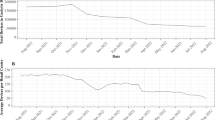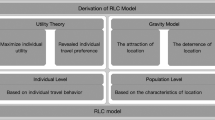Abstract
Aggregate time series and point-to-point panel data approaches to modelling Canadian long distance calling are compared. It is found that, while both models yield similar sets of aggregate elasticities, the point-to-point panel data models provide more detailed information on consumer behavior. Furthermore, the panel data models take advantage of the disaggregate data available and avoid the problems inherent in aggregate models when the rates of changes in the micro data are different.
Similar content being viewed by others
References
Acton JP, Vogelsang I (1990) Telephone demand over the Atlantic: evidence from country pair data. Rand Monograph R-3715-NSF/MT, Santa Monica: The RAND Corporation
Aigner J, Goldfeld SM (1974) Estimation and prediction from aggregate data when aggregates are measured more accurately than their components. Econometrica 42:113–134
Appelbe TW, Snihur NA, Dineen C, Farnes D, Giordano R (1989) Point-to-point demand modelling: An application to Canada-Canada and Canada-United States long distance calling. Information Economics and Policy 3:311–331
Appelbe TW, Dineen CR, Solvason DL, Hsiao C (1990) Econometric modelling of Canadian long distance calling: A comparison of aggregate time series versus point-to-point, panel data approaches. MRG No 9004, USC
Ashenfelter O (1978) Estmating the effect of training programs on earnings. Review of Economics and Statistics 60:47–57
Canadian Radio-Television and Telecommunications Commission (CRTC) (1988) Telecom Public Notice 1988-45
Chipman J (1985) Testing for reduction of mean square error by aggregation in dynamic econometric models. In: Multivariate analysis VI: Proceedings of the sixth internation symposium on multivariate analysis. North-Holland, Amsterdam
De Fontenay A, Shugard M, Sibley D (1990) Telecommunications demand modelling: An integrated view. North-Holland, Amsterdam
Friedman, M (1953) Essays in positive economics. University of Chicago Press, Chicago
Geisser S (1980) A predictivistic primer. In: Bayesian analysis in econometrics and statistics: Essays in Honor of Harrod Jeffreys. North-Holland, Amsterdam, pp 363–382
Griffin JM (1982) The welfare implications of externalities and price elasticities for telecommunications pricing. Review of Economics and Statistics 64:59–66
Grunfeld Y, Griliches Z (1960) Is aggregation necessarily bad? Review of Economics and Statistics 42:1–13
Hausman JA (1978) Specification test in econometrics. Econometrica 46:1251–1271
Hsiao C (1985) Benefits and limitations of panel data. Econometric Reviews 4:121–174
Hsiao C (1986) Analysis of panel data. Cambridge University Press, New York
Hsiao C, Mountain DC, Tsui KY, Luke Chan MW (1989) Modelling Ontario regional electricity system demand using a mixed fixed and random coefficients approach. Regional Science and Urban Economics 19:565–587
Klein LR (1988) The statistical approach to economics. Journal of Econometrics 37:7–26
Larson AC, Lehman DE, Weisman DL (1990) A general theory of point-to-point long distance demand. In: Telecommunications demand modelling, ed. by de Fontenay A, Shugard M, Sibley D, North-Holland, Amsterdam
Pacey PL (1983) Long distance demand: a point-to-point model. Southern Economic Journal 50:1094–1107
Ringwald K (1980) A critique of models in linear aggregation structures. Boston: Oelgeschlager, Gunn and Hain
Taylor L (1980) Telecommunications demand: a survey and critique. Ballinger, Cambridge
Telecom Canada, Demand Analysis (1988a) Econometric models of demand for customer-dialed Canada-Canada message toll service
Telecom Canada, Demand Analysis (1988b) Econometric models of demand for customer-dialed Canada-United States message toll service
Telecom Canada, Demand Analysis (1989) Econometric models of demand for customer-dialed Canada-Canada and Canada-United States Message Toll Service
Theil H (1954) Linear aggregation of economic relations. North Holland, Amsterdam
Zellner A (1988) Bayesian analysis in econometrics. Journal of Econometrics 37:27–50
Author information
Authors and Affiliations
Additional information
Cheng Hsiao's work is supported in part by National Science Foundation grant SES 88-21205. We wish to thank referees for helpful comments.
Telecom Canada is an association of the major Canadian Telephone companies that was formed to manage, among other things, the transmission of long distance calls between the companies.
Rights and permissions
About this article
Cite this article
Appelbe, T.W., Dineen, C.R., Solvason, D.L. et al. Econometric modelling of Canadian long distance calling: A comparison of aggregate time series versus point-to-point panel data approaches. Empirical Economics 17, 125–140 (1992). https://doi.org/10.1007/BF01192479
Issue Date:
DOI: https://doi.org/10.1007/BF01192479




